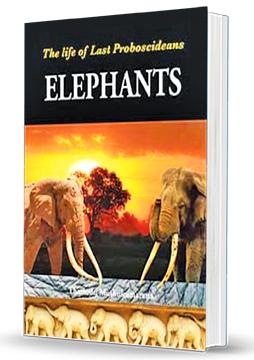
“I think Tharindu was once an elephant (in another life). And now, he’s been born again to save the elephants.”- Gamini Jayawickrema Perera, then Minister of Wildlife and Sustainable Development at the launch of 23-year-old Tharindu Muthukumarana’s mammoth undertaking, “The Life of Last Proboscideans: Elephants” at Kadirgarmar Centre on August 13.
Dedicating his gigantic work to well-wishers and conservationists, Tharindu raises concerns about an impending danger of a total extinction of Asian elephants during the anthropogenic Holocene extinction.
The book’s authenticity, clarity of thought and complete production of established facts blended with original ideas, makes it a very readable and moving text.
The chapter under ‘Mythology….’ makes it intermittently amusing, but not overly exhaustive. Tharindu deserves acclaim, and should be congratulated on his presentation of the complex events of this category of giants on land. It is a helpful volume from the point of view of understanding the world of pachyderms.
Mankind
This book should be read not only for the minute details of the elephant population, but also for the alerts it provides. ‘If history’s lessons were not heeded, Mankind is surely destined to be consumed by them’. Very occasionally a book comes along, that changes your life, in the sense that it alters your thinking and causes you to reevaluate the things that “everyone knows.” ‘…Elephants by Tharindu Muthukumarana is such a book.
On one level, it is a book about the animal kingdom, about human culture, which does not sound particularly promising. The study of pachyderms can be a niche subject, and it can be arid. The book starts from what may seem an innocuous topic: However, that includes both, the entire history of life on earth and the history of Proboscideans itself, and the book is notable for both, its breadth and depth. It focuses in detail, on single events, and offers a comprehensive overview of the pachyderm’s history and existence.
Tharindu challenges many of the universal beliefs about what we ‘think we know’ about the intricacies of nature at a point when the question of ‘ELEPHANT HUMAN CONFLICT’ is a daily topic in the media and the public sense of right and wrong.
A perceptible feature of the book is the way it constructs its overarching accounts from meticulously-researched facts. The text is straightforward, and full of well-expressed remarks that reverberate long after the book has been read.
One of the most fascinating passages in the book is a discussion of elephant participation in religious rituals. The book is profusely illustrated, with hundreds of photographs, sketches, and illustration to demonstrate the paragraphs in the text. He soaks up animal facts and explains eco systems; there are chapters formed around behaviours and defence systems, and an absorbing chapter on the history of life on earth. The book is divided into several sections. Its ‘art’ is simple and amazing. I would say, the length alone makes it better suited to upper elementary and middle school elephant lovers.
There is ample white space around the illustrations and the text, making it less visually distracting. A great way to start senior schoolchildren on their reading journey, as well as, learning about the environment and elephants.
Hypothesis
A reader would value the descriptions on elephants’ intelligence, the intricacy of their lives and families and their skill to endure famine and human brutality. One can discover the tenderness of the animal, how their trunks reach out and gently stroke a nervous toddler and a fierce commitment to defend their kind in the face of devastatingly superior force.
The book gathers almost one-and-a-half decades’ worth of studying elephants into a single volume. “….Elephants” is important for contravening decades-old hypothesis about elephant behaviour and facilitates a conversant approach to saving the elephant and discovering better ways to support labours that would see humans living happily side by side with these wonderful non-humans. There are still hunters and poachers who shoot elephants for their ivory. The book enlightened me on many such cruel practices. Tharindu’s observations of courtship, birth, communication, death, and social structure of the species kept my interest to the end.
The author is a ground researcher with long hours of first hand observation of untamed and tamed elephants. Tharindu strikes a balance between talking scientifically relevant information and amusing the reader. It is both, good science and good writing.
Ever since I can commit to memory, elephants have fascinated me. Their sheer dimension, fluttering ears, the echoing and trumpeting noises they make, the unhurried and methodical way they stroll and their amazingly attractive tusks fascinated me. The author has relieved me of all my reservations, doubts and speculations.
Clashes between elephants and people aren’t new, but they are growing. As human populations grow, territory becomes disjointed, with elephants losing more of the space they need to live.
But, the solutions to human-elephant conflicts are often politically provoked and can lead to brutality to animals. Individual elephants and whole family groupings may be fenced into insignificant areas or even culled.
Managing such conflicts entails great care; Tharindu has a solution. Finally, I admire the author for the work he has done and his dedication to the species; the world needs a few more youngsters like Tharindu Muthukumarana. I would recommend that anyone pick up this book for pleasure reading as well as an interesting scientific study of elephants.
K. K. S. Perera
